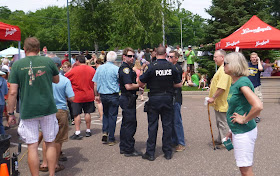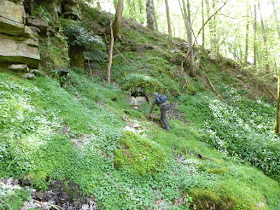My annual archaeology pilgrimages to Vindolanda have typically been two week stints. Oh, one year I could only manage a single week, and I have given brief whimsical consideration to doing a doubled up four week session next year if my then 60 year old carcass could stand the wear and tear.
But usually it is a week of excavating, two days to relax, then another week and home.
Naturally in the weekend of designated rest I don't sit still.
Being an "old timer" now it has come to pass that I have met quite a few folks, and usually my excavator pals and I concoct some kind of history themed activities for our non digging weekend. Today and next time you are invited to come along.
On a Saturday with extremely variable weather we set out to do a walk.
Our starting point was the parking lot at the Hadrian's Wall fort of Brocolita. This is one of my favorite ancient place names. It appears on the few ancient sources we have, and delightfully seems to preserve a Pre-Roman name. "Brock" meaning badger is a very old Celtic word. Brocolita has plausibly been interpreted as "the place with badger holes". Now, since my nick name with my digging pals is "Badger" (based on being from Wisconsin and somewhat black and white in color scheme), what would be more historically apt than Badger at the place of Badgers?
In the photo above I am standing not at the fort site but in a shrine just outside same. This is a very nicely preserved Mithraeum. The altars are reproductions, the originals now safely in a museum in Newcastle.
This was one of three shrines in a complex to the west of the fort. In some ways the coolest one was actually Coventina's Well. Coventina was (is?) a Romano-British water deity whose existence is basically only known from this site. Near where I am standing there was another enclosure in the middle of which was a spring. When excavated in 1876 it was a fabulous treasure trove. Altars, incense burners, votive offerings....and 13,487 Roman coins!
So, where is the well today?
Tempting, tempting, but this ain't it. Sure, its a well and just outside of the fort. And, yes, almost certainly that is Roman stonework. Why it even looks as if it were excavated a century or so ago, and I have seen pipes left in sites for various reasons. But, wrong place. This is a remnant of some farmer's miserable little stead. Rock and scruffy grass did not make for prosperity even if you could save money by simply pinching nearby bits of stone work for construction.
The actual site of Coventina's Well is unmarked. It stands to reason that if there were 13,000 Roman coins excavated then there could be a few still in the ground. So the Management has not made the site blatant and I will abide by that wise policy.
Up and down the hills we went north of the Wall and into Disputed Territories. We stopped in a little hamlet called Simonburn. It has a very pleasant Tea Room. While there I browsed through their local history book and noticed that there was a 13th Century church, St. Mungo's, that was on the site of even earlier sanctuaries. In fact, it was said that Mungo himself had visited and had baptized Dark Age Pagans at "St. Mungo's Well" near the church.
Ah, sacred wells, pagans, a guy named Mungo....had to visit.
The hunt for the wells started at the church, then went down a ravine to the south and over a small creek. High up on the other side we found several possible suspects...
All were suitably moss encrusted and had water in them and/or running out of them. The water did not seem to have any particular influence on the less devout among our little band but perhaps the absence of St. Mungo was part of the problem. The obviously later brickwork was not actually a deal breaker as it is common place for ancient springs to have some modern work on them either to protect the water source or to keep people and animals from falling in and coming to grief.
Ah, alas for mystery and history. It seems that these water sources are newer and less holy. Known as far back as the 18th century as "Mugger's Well" a vicar of Victorian times decided - for no particular reason - that this must be a typo of sorts and just renamed them.
A Mugger in this context means a travelling peddler who sold crockery. I can imagine such folks using this as a nice campsite. The alternate and more common use of Mugger is to describe a violent robber, someone who might hit you in "the mug". It gets a little help along the way from a Hindu word that is used to designate a large and rather mean spirited crocodile which would be equally happy to grab hold of either end of you.



















































